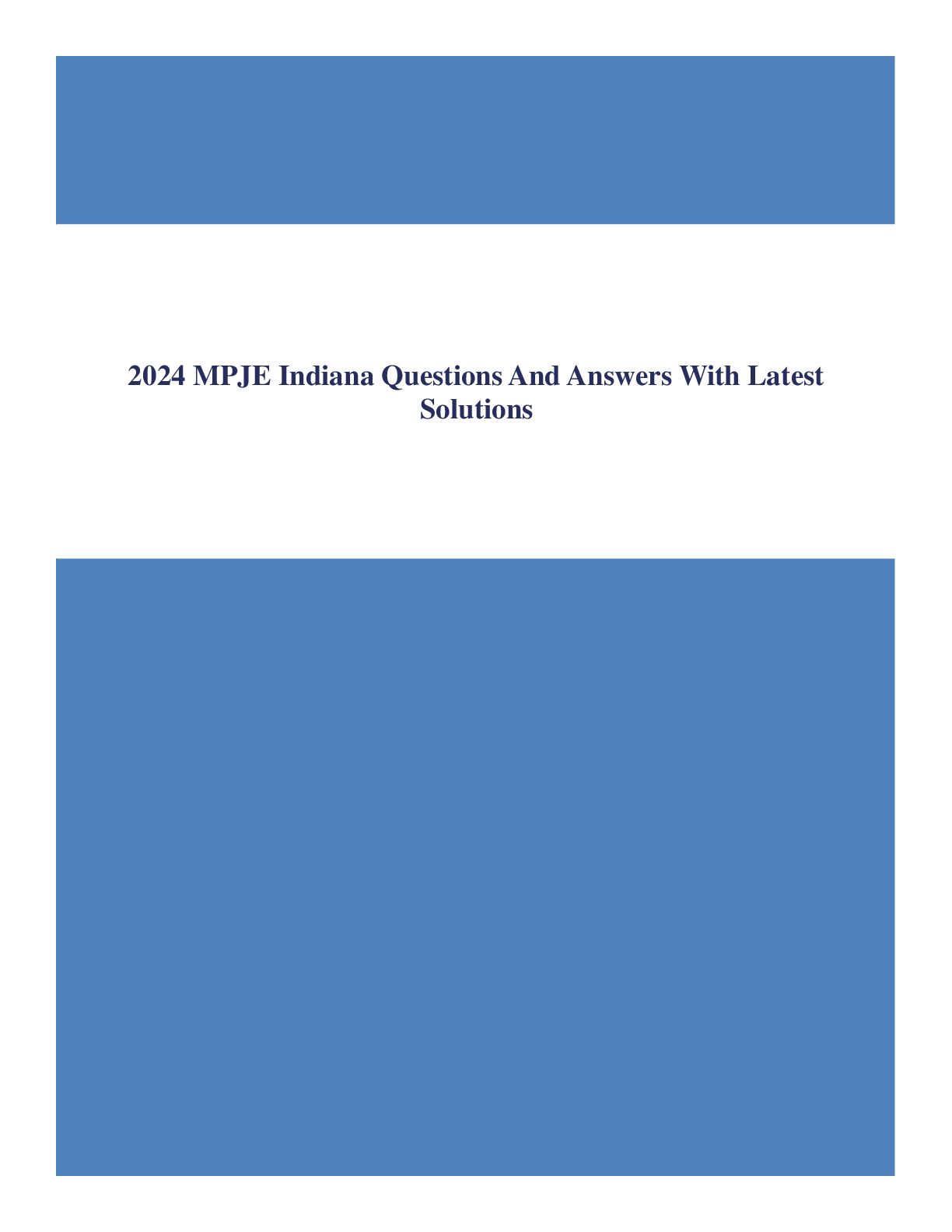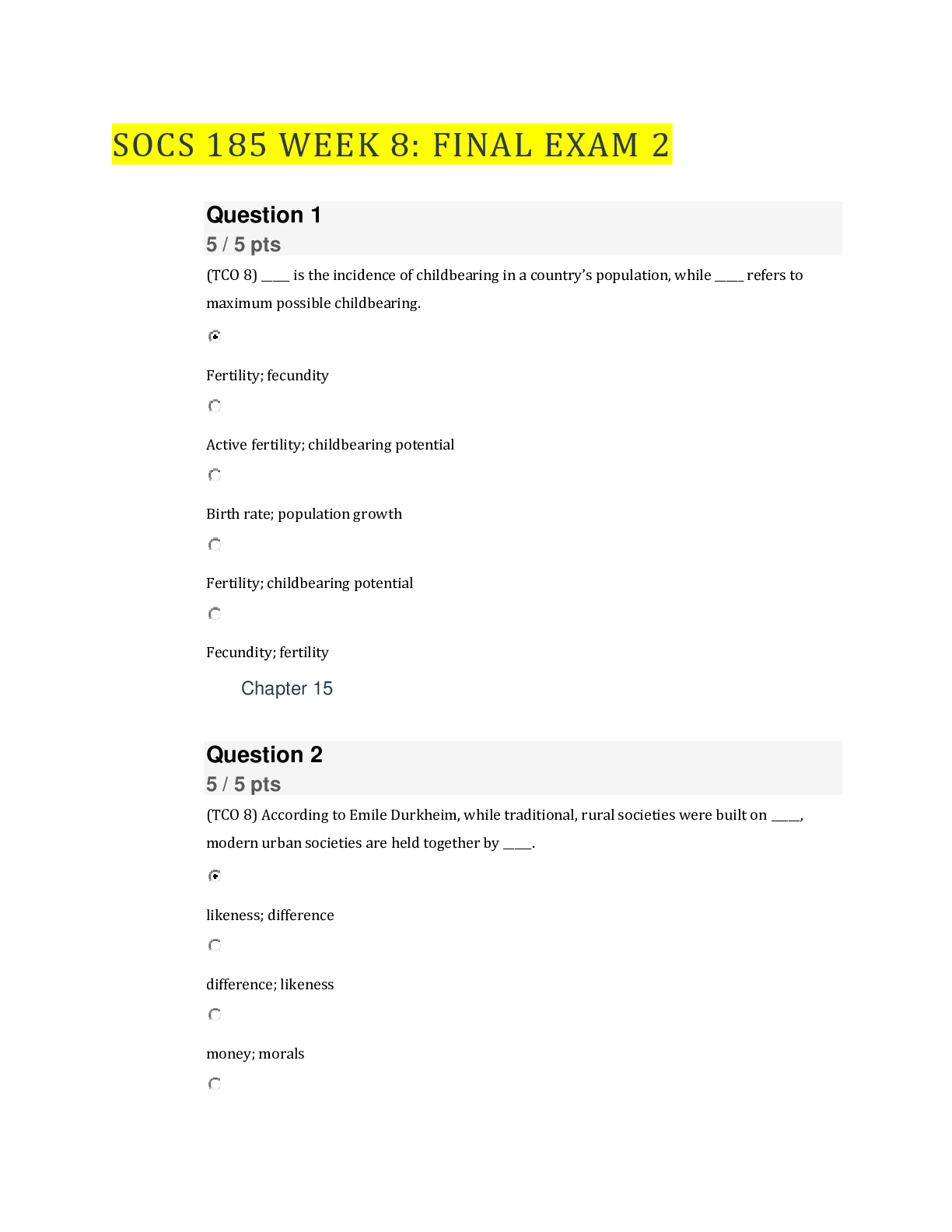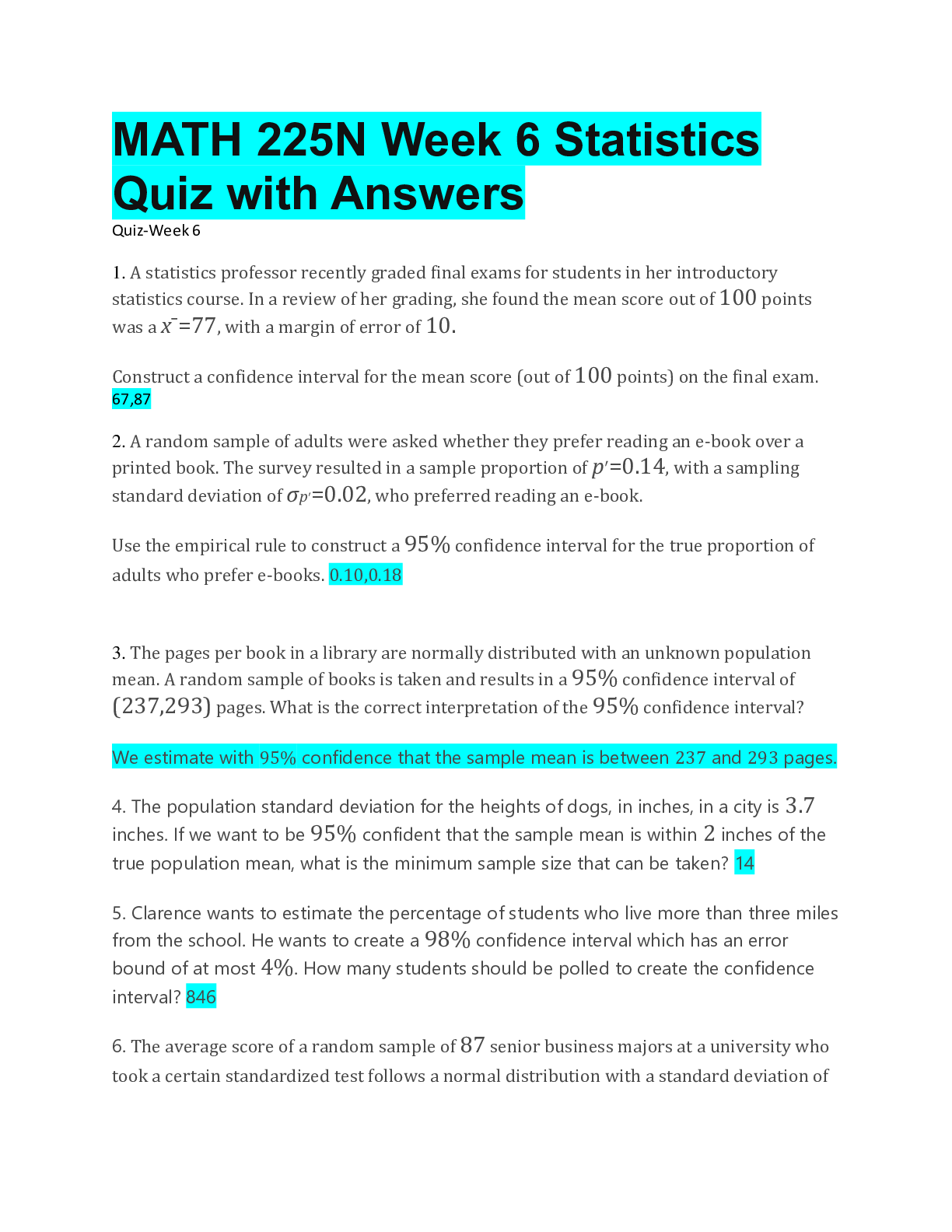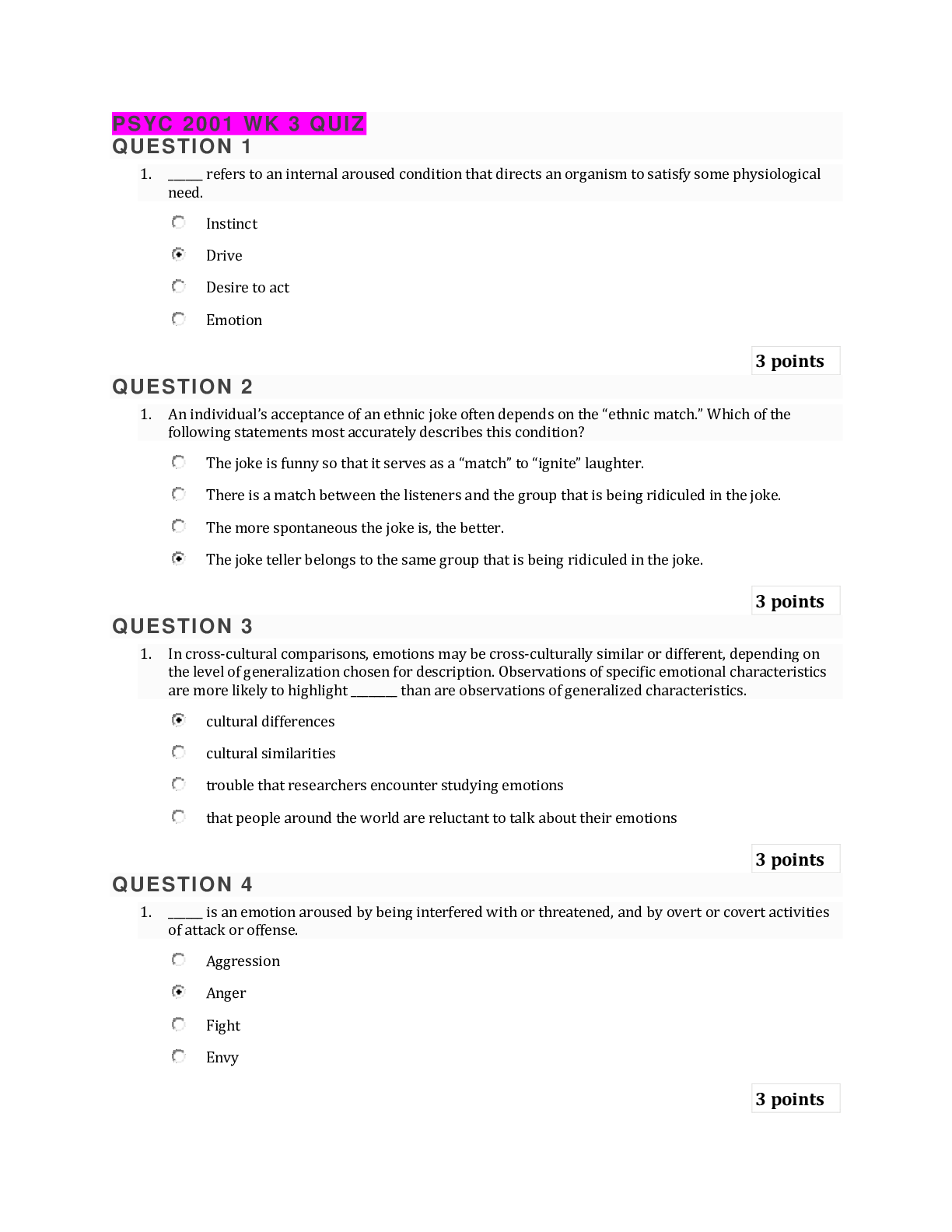MN 551 Quiz Week 3 | LATEST VERSION
Document Content and Description Below
1 / 1 point A patient is experiencing impaired circulation secondary to increased systemic arterial pressure. Which of the following statements is the most relevant phenomenon? Question options: I... ncreased preload due to vascular resistance High afterload because of backpressure against the left ventricle Impaired contractility due to aortic resistance Systolic impairment because of arterial stenosis Question 2 1 / 1 point A 54-year-old man with a long-standing diagnosis of essential hypertension is meeting with his nurse practitioner. The patient's nurse practitioner would anticipate that which of the following phenomena is most likely occurring? Question options: The conversion of angiotensin I to angiotensin II in his lungs causes increases in blood pressure and sodium reabsorption. Vasopressin is exerting an effect on his chemoreceptors and baroreceptors, resulting in vasoconstriction. Epinephrine from his adrenal gland is initiating the renin-angiotensin-aldosterone system. The patient's juxtaglomerular cells are releasing aldosterone as a result of sympathetic stimulation. Question 3 1 / 1 point A patient in the intensive care unit has a blood pressure of 87/39 and has warm, flushed skin accompanying his sudden decline in level of consciousness. The patient also has arterial and venous dilation and a decrease in systemic vascular resistance. What is this patient's most likely diagnosis? Question options: Obstructive shock Neurogenic shock Septic shock Hypovolemic shock Question 4 1 / 1 point A 55-year-old male who is beginning to take a statin drug for his hypercholesterolemia is discussing cholesterol and its role in health and illness with his nurse practitioner. Which of the following aspects of hyperlipidemia would the nurse practitioner most likely take into account when teaching the patient? Question options: Hyperlipidemia is a consequence of diet and lifestyle rather than genetics. HDL cholesterol is often characterized as being beneficial to health. Cholesterol is a metabolic waste product that the liver is responsible for clearing. The goal of medical treatment is to eliminate cholesterol from the vascular system. Question 5 1 / 1 point Which of the following assessment findings in a newly admitted 30-year-old male patient would be most likely to cause his nurse practitioner to suspect polyarteritis nodosa? Question options: The man's temperature is 101.9°F and he is diaphoretic (heavily sweating). The man is acutely short of breath and his oxygen saturation is 87%. The man's blood pressure is 178/102 and he has abnormal liver function tests. The man's blood work indicates polycythemia (elevated red cells levels) and leukocytosis (elevated white cells). Question 6 1 / 1 point In which of the following patient situations would a nurse practitioner be most justified in preliminarily ruling out pericarditis as a contributing pathology to the patient's health problems? Question options: A 60-year-old woman whose admission blood work indicates elevated white cells, erythrocyte sedimentation rate, and C-reactive protein levels A 56-year-old obese man who is complaining of chest pain that is exacerbated by deep inspiration and is radiating to his neck and scapular ridge A 77-year-old with diminished S3 and S4 sounds, an irregular heart rate, and a history of atrial fibrillation A 61-year-old man whose ECG was characterized by widespread T wave inversions on admission but whose T waves have recently normalized Question 7 1 / 1 point A nurse practitioner has ordered the measurement of a cardiac patient's electrolyte levels as part of the patient's morning blood work. Which of the following statements best captures the importance of potassium in the normal electrical function of the patient's heart? Question options: The reciprocal movement of one potassium ion for one sodium ion across the cell membrane results in the production of an action potential. The impermeability of cardiac cell membranes to potassium allows for action potentials achieved by the flow of sodium ions. Potassium is central to establishing and maintaining the resting membrane potential of cardiac muscle cells. Potassium catalyzes the metabolism of ATP, producing the gradient that results in electrical stimulation. Question 8 1 / 1 point As part of the diagnostic workup for a male patient with a complex history of cardiovascular disease, the care team has identified the need for a record of the electrical activity of his heart, insight into the metabolism of his myocardium, and physical measurements, and imaging of his heart. Which of the following series of tests is most likely to provide the needed data for his diagnosis and care? Question options: Cardiac catheterization, cardiac CT, exercise stress testing Serum creatinine levels, chest auscultation, myocardial perfusion scintigraphy Ambulatory ECG, cardiac MRI, echocardiogram Echocardiogram, PET scan, ECG Question 9 0 / 1 point A patient has suffered damage to his pericardium following a motor vehicle accident. Which of the following consequences should the nurse practitioner be most likely to rule out? Question options: Impaired physical restraint of the left ventricule Increased friction during the contraction/relaxation cycle Reduced protection from infectious organisms Impaired regulation of myocardial contraction Question 10 1 / 1 point An older adult female patient has presented with a new onset of shortness of breath, and the patient's nurse practitioner has ordered measurement of her BNP levels along with other diagnostic tests. What is the most accurate rationale for the nurse practitioner's choice of blood work? Question options: BNP becomes elevated in cases of cardiac asthma, Cheyne-Stokes respirations, and acute pulmonary edema, and measurement can gauge the severity of pulmonary effects. BNP levels correlate with the patient's risk of developing cognitive deficits secondary to heart failure and consequent brain hypoxia. BNP is an indirect indicator of the effectiveness of the RAA system in compensating for heart failure. BNP is released as a compensatory mechanism during heart failure and measuring it can help differentiate the patient's dyspnea from a respiratory pathology. Question 11 1 / 1 point A 31-year-old woman with a congenital heart defect reports episodes of lightheadedness and syncope, with occasional palpitations. A resting electrocardiogram reveals sinus bradycardia and she is suspected of having sick sinus syndrome. Which of the following diagnostic methods is the best choice to investigate the suspicion? Question options: Holter monitoring Electrophysiologic study Exercise stress testing Signal-averaged ECG Question 12 1 / 1 point The nurse practitioner for a cardiology practice is responsible for providing presurgical teaching for patients who are about to undergo a coronary artery bypass graft. Which of the following teaching points best conveys an aspect of the human circulatory system? Question options: “Your blood pressure varies widely between arteries and veins, and between pulmonary and systemic circulation.” “Only around one quarter of your blood is in your heart at any given time.” “Blood pressure and blood volume roughly mimic one another at any given location in the circulatory system.” “Left-sided and right-sided pumping action at each beat of the heart must equal each other to ensure adequate blood distribution.” Question 13 1 / 1 point A 72-year-old woman with a recent onset of syncopal episodes has been referred to a cardiology group by her family physician. As part of the patient's diagnostic workup, the nurse practitioner conducting the intake assessment has ordered a Holter monitor for 24 hours. Which of the following statements best captures an aspect of Holter monitoring? Question options: Holter monitors are normally set to record electrical activity of the heart at least once per hour. Accurate interpretation of the results requires correlating the findings with the activity that the woman was doing at the time of recording. The primary goal is to allow the cardiologist to accurately diagnose cardiomyopathies. A Holter monitor is preferable to standard ECG due to its increased sensitivity to cardiac electrical activity. Question 14 1 / 1 point A number of patients have presented to the emergency department in the last 24 hours with complaints that are preliminarily indicative of myocardial infarction. Which of the following patients is least likely to have an ST-segment myocardial infarction (STEMI)? Question options: A 71-year-old man who has moist skin, fever, and chest pain that is excruciating when he moves but relieved when at rest A 43-year-old man who woke up with substernal pain that is radiating to his neck and jaw A 66-year-old man who has presented with fatigue, nausea and vomiting, and cool, moist skin A 70-year-old woman who is complaining of shortness of breath and vague chest discomfort Question 15 1 / 1 point A 68-year-old male complains to his nurse practitioner that when he tests his blood pressure using a machine at his pharmacy, his heart rate is nearly always very low. At other times, he feels that his heart is racing, and it also seems to pause at times. The man has also occasionally had lightheadedness and a recent syncopal episode. What is this patient's most likely diagnosis and the phenomenon underlying it? Question options: Ventricular arrhythmia as a result of alternating vagal and sympathetic stimulation Sick sinus syndrome as a result of a disease of his sinus node and atrial or junctional arrhythmias Premature atrial contractions that vacillate between tachycardic and bradycardic episodes as a consequence of an infectious process Torsades de pointes as a result of disease of the bundle of His Question 16 1 / 1 point An autopsy is being performed on a 44-year-old female who died unexpectedly of heart failure. Which of the following components of the pathologist's report is most suggestive of a possible history of poorly controlled blood pressure? Question options: “Arterial sclerosis of subcortical brain regions noted.” “Vessel wall changes suggestive of venous stasis are evident.” “Bilateral renal hypertrophy noted.” “Scarring of urethra suggestive of recurrent urinary tract infections is evident.” Question 17 0 / 1 point An 81-year-old male resident of a long-term care facility has a long-standing diagnosis of heart failure. Which of the following short-term and longer-term compensatory mechanisms is least likely to decrease the symptoms of his heart failure? Question options: AV node pacemaking activity and vagal nerve suppression Activation of the renin-angiotensin-aldosterone (RAA) system and secretion of brain natriuretic peptide (BNP) Sympathetic stimulation and increased serum levels of epinephrine and norepinephrine An increase in preload via the Frank-Starling mechanism Question 18 1 / 1 point A 66-year-old patient's echocardiogram reveals a hypertrophied left ventricle, normal chamber volume, and a normal ejection fraction from the heart. What is this patient's most likely diagnosis? Question options: Aortic valve regurgitation Mitral valve stenosis Aortic valve stenosis Mitral valve regurgitation Question 19 1 / 1 point A 22-year-old male is experiencing hypovolemic shock following a fight in which his carotid artery was cut with a broken bottle. What immediate treatments are likely to most benefit the man? Question options: Administration of oxygen and epinephrine to promote perfusion Infusion of normal saline of Ringer lactate to maintain the vascular space Infusion of vasodilators to foster perfusion and inotropes to improve heart contractility Resolution of compensatory pulmonary edema and heart arrhythmias Question 20 1 / 1 point An 81-year-old female patient of a long-term care facility has a history of congestive heart failure. The nurse practitioner caring for the patient has positioned her sitting up at an angle in bed and is observing her jugular venous distention. Why is jugular venous distention a useful indicator for the assessment of the patient's condition? Question options: Increased cardiac demand causes engorgement of systemic blood vessels, of which the jugular vein is one of the largest. Blood backs up into the jugular vein because there are no valves at the point of entry into the heart. Peripheral dilation is associated with decreased stroke volume and ejection fraction. Heart valves are not capable of preventing backflow in cases of atrial congestion. Question 21 1 / 1 point A nurse practitioner is instructing a group of older adults about the risks associated with high cholesterol. Which of the following teaching points should the participants try to integrate into their lifestyle after the teaching session? Question options: “Remember, the 'H' in HDL and the 'L' in LDL correspond to high danger and low danger to your health.” “Having high cholesterol increases your risk of developing diabetes and irregular heart rate.” “Smoking and being overweight increases your risk of primary hypercholesterolemia.” “Your family history of hypercholesterolemia is important, but there are things you can do to compensate for a high inherited risk.” Question 22 1 / 1 point Which of the following situations related to the transition from fetal to perinatal circulation would be most likely to necessitate medical intervention? Question options: Pulmonary vascular resistance, related to muscle regression in the pulmonary arteries, rises over the course of the infant's first week. Systemic vascular resistance and left ventricular pressure are both increasing. Alveolar oxygen tension increases, causing reversal of pulmonary vasoconstriction of the fetal arteries. Pressure in the pulmonary circulation and the right side of the infant's heart fall markedly. Question 23 1 / 1 point A 66-year-old obese man with a diagnosis of ischemic heart disease has been diagnosed with heart failure that his care team has characterized as attributable to systolic dysfunction. Which of the following assessment findings is inconsistent with his diagnosis? Question options: Ventricular dilation and wall tension are significantly lower than normal. He is presently volume overloaded following several days of intravenous fluid replacement. His end-diastolic volume is higher than normal and his resting heart rate is regular and 82 beats per minute. His resting blood pressure is normally in the range of 150/90 and an echocardiogram indicates his ejection fraction is 30%. Question 24 1 / 1 point During a routine physical examination of a 66-year-old woman, her nurse practitioner notes a pulsating abdominal mass and refers the woman for further treatment. The nurse practitioner is explaining the diagnosis to the patient, who is unfamiliar with aneurysms. Which of the following aspects of the pathophysiology of aneurysms would underlie the explanation the nurse provides? Question options: Aneurysms can normally be resolved with lifestyle and diet modifications. Individuals with an aneurysm are normally asymptomatic until the aneurysm ruptures. Hypertension is a frequent modifiable contributor to aneurysms. Aneurysms are commonly a result of poorly controlled diabetes mellitus. Question 25 1 / 1 point A nurse practitioner is teaching a student NP about the physiologic basis for damage to the circulatory and neurological systems that can accompany hypotension. Which of the following responses by the student would warrant correction by the nurse practitioner? Question options: “As vessel wall thickness increases, tension decreases.” “Smaller blood vessels require more pressure to overcome wall tension.” “The smaller the vessel radius, the greater the pressure needed to keep it open.” “Tension and vessel thickness increase proportionately.” [Show More]
Last updated: 2 years ago
Preview 1 out of 5 pages

Buy this document to get the full access instantly
Instant Download Access after purchase
Buy NowInstant download
We Accept:

Reviews( 0 )
$12.00
Can't find what you want? Try our AI powered Search
Document information
Connected school, study & course
About the document
Uploaded On
Jan 29, 2021
Number of pages
5
Written in
Additional information
This document has been written for:
Uploaded
Jan 29, 2021
Downloads
0
Views
62
























